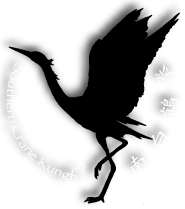Master Zhang Yang Lin is head of the Zhang Cheng Kungfu Training Centre in Yong Tai, Yong Tai County, China. Here, Master Lin talks to the Southern Crane Kungfu team that travelled to China in October 2007, led by Chief Instructor, Darren Trottman.
This interview with Master Lin was conducted by Assistant Instructor at Southern Crane Kungfu, Heather McLean.
HM: “Master Lin, can you please tell me how you began training in Southern Tiger Boxing?”
ML: “I have always lived in Yong Tai County. I used to live in the countryside. After I graduated I taught in the village where I was born, Bai Yun Village, which means White Cloud Village in English. When I was 10 or 11 years old, I started to learn kungfu; not Tiger Boxing, but just a few techniques that I learnt from my cousin. When my cousin started practising Tiger, I would copy, even though he wasn’t a Master. I was very enthusiastic about kungfu.
In 1989 I was at my high school, ready to enter college. I had to take examinations to be able to continue my study, including one physical exercise exam, and one exam was in kungfu. Because kungfu was something I wanted to continue in higher education, my parents gave me their permission to study it.”
HM: “So, how did you then find a Tiger Master?”
ML: “My uncle got me a good Tiger Master then, so I could train under him in a very systematic way, as I have continued to do from that time to now. At that time kungfu was a very secret thing, and it cost a lot to learn. Luckily my uncle had a work mate who was a Tiger Master. It was not easy to find a good teacher to teach kungfu, but luckily, as a boy, the kungfu Master my uncle found for me didn’t care too much about me, so I could watch and learn. The Tiger Master said I could copy everything from the side lines, with no payment needed; I could just copy and learn without being specifically taught.
I got a good mark for my kungfu exam that year and I entered the sports college, which laid a good foundation for my teaching career. After I passed my exam, my first Sifu got me a second Sifu in the town of Yong Tai so I could learn Tiger Boxing in my own time. When I entered the sports college, I got three coaches to teach me wushu as well, during school time.
I taught physical education at Bai Yun Middle School after I graduated from college in July 1992. I taught at that middle school for two years, and in that time a kungfu coach working in a teenage sports school in town left, so there was a position free. I was the ideal candidate for the job, so I was able to take it.”
HM: “Yong Tai is famous for its Tiger Boxing style of fighting, isn’t it?”
ML: “Yes. We are living in a remote mountainous area. In the past this area was full of tigers. Our ancestors observed the tiger and mimicked it; I know their story from written records and the narration of past Masters. We seldom have tigers now, so I watch them on TV or in films.
As Yong Tai is a mountainous area, the main weapons are farming tools and household items. We use a bamboo pole on which we hang clothes to dry, and the supports of the pole, which are made from bamboo or wood, usually bamboo. With the supports, we cut off most stems from the pole but we leave some cut a bit longer so that we can adjust the height of the washing [HM: Imagine a thick bamboo pole with small ‘arms’ pointing upwards at points along its length] and we use that for fighting.
We also use digging tools, such as hoes, water carriers, the staff, the sai, the broad sword and the bench [HM: sitting bench]. The same principles apply to different weapons.”
HM: “Finally, Master Lin, how has the way kungfu is used changed over the last few decades?”
ML: “When I started learning kungfu, my Master warned me not to use kungfu freely or to bully others with it. It was mainly for good health-keeping. But in the past, in this area, we got a lot of gangsters and there were also many conflicts between families as we had to struggle for resources, so in the past kungfu meant more about fighting. But now we mainly use it as a way of health keeping. Yet without offensive and defensive strategies, kungfu can be for nothing.”
